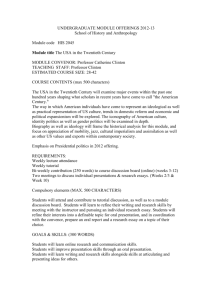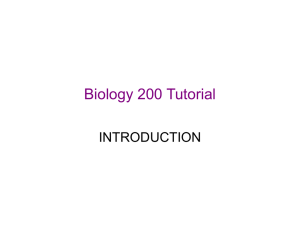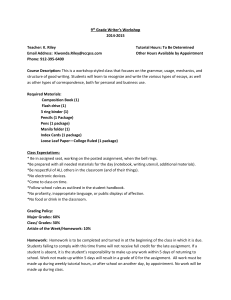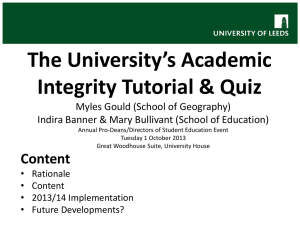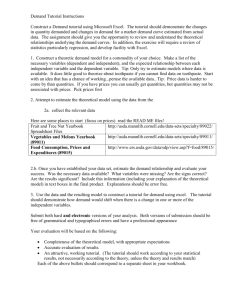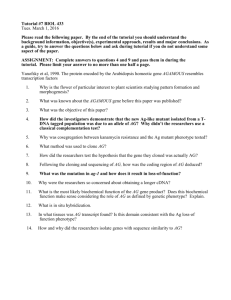הקורס: מקראה באנגלית /3871-090-01 מרצה : גב` רחל פיק Rachel Pick
advertisement
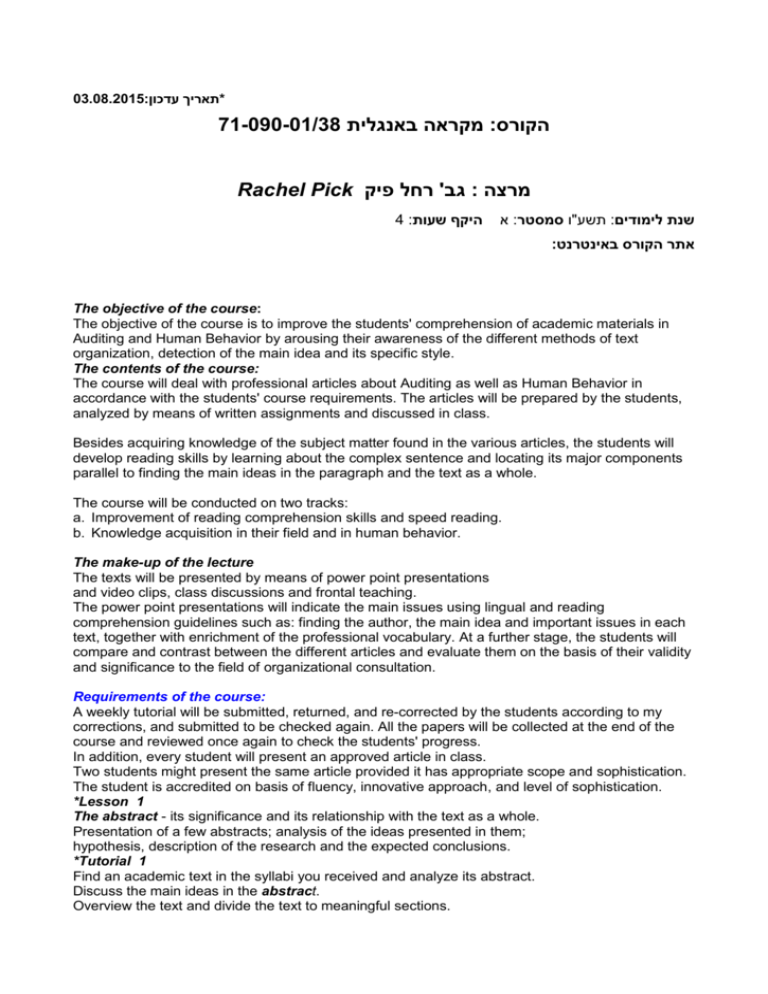
300380132.:*תאריך עדכון 12-393-32/38 מקראה באנגלית:הקורס Rachel Pick גב' רחל פיק: מרצה 4 :היקף שעות א: תשע"ו סמסטר:שנת לימודים :אתר הקורס באינטרנט The objective of the course: The objective of the course is to improve the students' comprehension of academic materials in Auditing and Human Behavior by arousing their awareness of the different methods of text organization, detection of the main idea and its specific style. The contents of the course: The course will deal with professional articles about Auditing as well as Human Behavior in accordance with the students' course requirements. The articles will be prepared by the students, analyzed by means of written assignments and discussed in class. Besides acquiring knowledge of the subject matter found in the various articles, the students will develop reading skills by learning about the complex sentence and locating its major components parallel to finding the main ideas in the paragraph and the text as a whole. The course will be conducted on two tracks: a. Improvement of reading comprehension skills and speed reading. b. Knowledge acquisition in their field and in human behavior. The make-up of the lecture The texts will be presented by means of power point presentations and video clips, class discussions and frontal teaching. The power point presentations will indicate the main issues using lingual and reading comprehension guidelines such as: finding the author, the main idea and important issues in each text, together with enrichment of the professional vocabulary. At a further stage, the students will compare and contrast between the different articles and evaluate them on the basis of their validity and significance to the field of organizational consultation. Requirements of the course: A weekly tutorial will be submitted, returned, and re-corrected by the students according to my corrections, and submitted to be checked again. All the papers will be collected at the end of the course and reviewed once again to check the students' progress. In addition, every student will present an approved article in class. Two students might present the same article provided it has appropriate scope and sophistication. The student is accredited on basis of fluency, innovative approach, and level of sophistication. *Lesson 1 The abstract - its significance and its relationship with the text as a whole. Presentation of a few abstracts; analysis of the ideas presented in them; hypothesis, description of the research and the expected conclusions. *Tutorial 1 Find an academic text in the syllabi you received and analyze its abstract. Discuss the main ideas in the abstract. Overview the text and divide the text to meaningful sections. *Lesson 2 The students receive an abstract with clear instructions. They discuss it with each other and write a short paragraph on it. The text by Morgan is introduced. *Tutorial 2 Find the main idea in Morgan's text. Discuss the major device the author is using in the text. *Lesson 3 Methods of text organization continued. "Organizations as Organisms" is continued Comparison and Contrast is expanded. The main issues in the text are discussed. *Tutorial 3 Write a short essay about: How does language reflect the concept of comparison and contrast, find the clues to meaning? What entities are being contrasted or compared, from what point of view? Is it a valid comparison/contrast? * Lesson 4 Discussion of the concept of 'happiness'. A questionnaireabout happiness is distributed and students fill it in. A discussion of happiness takes place. A power point presentation on "Who Is Happy?" Discussion of the opening paragraphof the text. Its functions as a 'predictor' of the contents that will follow. The importance of every sentence in the opening paragraph that arouses an expectation of the following facts. Presentation of a short essay on happiness that gives a different view of the topic. *Tutorial 4 The students will write on the concept of 'happiness'. *Lesson 5 "Who Is Happy" is continued. The different causes of happiness are discussed Different students present the different causes to the class. The students are instructed to 'find the author'. Discussion of the main idea. Analysis of the sentence - its basic components, with an emphasis on the adjective and adjectival clause as one of the means of finding the author in the text. Tutorial 5 Analyze specific paragraphs in detail: a. Choose the key sentences and analyze their basic components as instructed. b. Point out the adjectival clause, and adjectives and show their functions in the sentence and text. *Lesson 6 Students receive a form on change, fill it out, discuss their answers and present them to the class individually. The teacher points out the different meanings of change. Introduction of the concept of changeby means of a power point presentation of the abstract of the text:"Why Don't Continents Move? Why Don't People Change?" Prediction of the aspect of change in the text on basis of the abstract. Students write and submit a short paragraph on change. *Tutorial 6 a. Describe a successful/unsuccessful change you have experienced. Professional vocabulary that has been taught and discussed should be used to convey the ideas. Students prepare the text "Why Don't Continents Move?" *Lesson 7 Anover view of the text: "Why Don't Continents Move? Why Don't People Change?" Evaluation of the style and the structure of the text. The class is divided to some groups. Every group deals with one section and makes up a few questions on it. Every group points out : what is unique about its section and what they have gained from it and from the text as a whole. *Tutorial 7 State the main ideas in one section and specify what you have gained from them and how it is related to the rest of the text. *Lesson 8 "Decisions and Revisions" appears in bold letters on the screen. The students receive an introductory questionnaire on the topic. They discuss it among themselves and present their ideas individually. The abstract of the text "Decisions and Revisions" is distributed and the students are requested to analyze it and predict the main issues. The abstract is analyzed andsummarized. The first two paragraphs are read and explained in class. This text is more sophisticated regarding the ideas presented and the complexity of its sentences. Clarifications are given about the complex sentence, its components, the importance of detecting its major components and guidance as to how to do it. Teaching how to detect the major components of the complex sentence, thus enabling the student to find the main clause which is the essence of the sentence and comprehend it more easily and more speedily. *Tutorial 8 1. Choose the major sentences in the first two sections detect their major components according to: a. the structure major components. b. contents & meaning. 2. Find a video clip that is related to the text & send it to me. *Lesson 9 Review of the homework. Discussion of the next two sections of the text. Power point presentation of choice paragraphs with an emphasis on the means of how to detect the key sentences in each paragraph. *Tutorial 9 Write on the pros and cons of decisions and revisions concerning: married life and purchase according to the text. Evaluate the author's approach and state your personal point of view on the issue. *Lesson 10 Students present their written assignment. A discussion follows. Discussion of the beautiful endingof the text. The students write in class a short essay on: 'If life is an apple . mine is the best". The essay is submitted. An introduction of the next text by means of a questionnaire on: How everyone got his/her job. *Tutorial 10 Prepare the text: 'Getting Things Done: "How to make people decisions." *Lesson 11 A student who is an experienced interviewer has been asked: a. to prepare a job interview b. actually interview one of the students. The interview will take place as soon as a 'volunteer' is found. A discussion about the significance of the interview will follow together with an evaluation of whether or not it is a fair experience . A presentation of the abstract of the text Getting Things Done: "How to make people decisions." The discussion of the abstract is followed by an overview of the text and the statement of the main ideas. *Tutorial11 Write on one of the following topics. a. Pros and cons of the function of the job interview. b. Is the interview a must or should it be replaced by a different means. *Lesson 12 Discussion of the major ideas in the text. Students brain storm on basis of their experience at work. A questionnaire about the guiding principles of hiring people is distributed. Students discuss the principles among themselves and choose the ones they believe are most meaningful and have long lasting effects. Discussion of the subtitles and the structure of the text. Vocabulary review by means of a form that is distributed in class. *Tutorial Students submit a folder with all the versions of every tutorial. *Lesson 13 Introduction of the last text "Excuses, excuses". A questionnaire on the abstract of "Excuses". Discussion of the answers. Overview of the text, division to sections and finding the author. Analysis of choice key sentences. *Tutorial 13 Write what you have gained from the course. *Lesson 14 Every student receives the paragraph he wrote during the first lesson depicting his expectations from the course. Each student is asked to comment on it. The students are given a feedback questionnaire and fill it out adding recommendations for the improvement of the course. To conclude a. I reviewtopics and issues based on students' requests. b. We discuss the final exam–the texts that will be included and the knowledge they are expected to master. Grades The passing grade is 60% The final grade of the course is composed of two components: a. The class grade - 70% b. The examination - 30% (provided the score on the exam is 60%) a. The class grade entails: i. Active participation and attendance, ii. Weekly tutorials iii. Presentation b. The examination grade: At the end of the course the student is tested on materials studied in class. The student is supposed to be able to compare and contrast between the texts and evaluate them on basis of contextual, organizational principles. Bibliography 1. Drucker, Peter.E. Getting Things Done: "How to make people decisions"*Freedman,David.H. "Is Management still a Science", Harvard Business Review, January 1, 1985. (148895 ( כתב עת בספרית כלכלה וגם כתב עת אלקטרוני 2. Gilbert, D.T. and Ebert, J. E. J. "Decisions and Revisions," Journal of Personality and Social Psychology, 82:4 (2002), 503-514. (118869( כתב עת בספריה לפסיכולוגיה וגם כתב עת אלקטרוני 3. Morgan, Gareth. "Images of Organization. Nature Intervenes: Organizations as Organisms". Canadian Public Administration,Vol.32, Issue 2, (1989) pp.320-339. ).10125( כתב עת אלקטרוני 4. . Prochaska, James O. and Prochaska, Janice, M. "Why Don't Continents Move? Why Don't People Change?,"Journal of Psychotherapy Integration, Vol.9, No.1, pp.83-102,1999. )0.9353( כתב עת אלקטרוני 5. Snyder, C.R. "Excuses, Excuses", Psychology Today(18), September, 1984. (132231(כתב עת בספריה לפסיכולוגיה האלקטרוני לא חל על שנה זו




